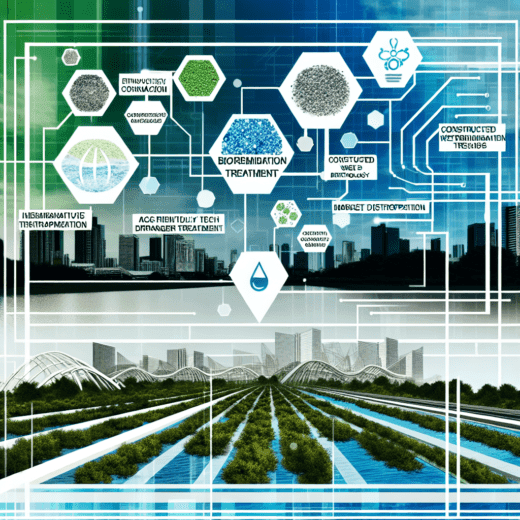Introduction
This blog post delves into the poignant issue of acid mine drainage (AMD) treatment, spotlighting the innovative eco-friendly solutions emerging from the startup ecosystem. AMD, a byproduct of mining operations, poses severe environmental challenges, contaminating waterways with toxic heavy metals and acidic water, thus necessitating urgent and sustainable management strategies. The burgeoning field of AMD treatment is brimming with potential for innovation and market disruption, presenting unique opportunities and challenges for startups aiming to conquer this niche. This comprehensive exploration presents a vivid tapestry of strategies for fundraising, scaling operations, achieving product-market fit, navigating customer acquisition, and uncovering distinctive aspects of business models in this sector.
Understanding Acid Mine Drainage
Acid mine drainage is a significant environmental concern associated with mining activities. It occurs when sulfide minerals exposed during mining operations react with oxygen and water to produce sulfuric acid, which then leaches toxic metals from surrounding rocks. These acidic effluents can severely impact ecosystems, killing aquatic life and rendering water unsafe for human consumption. The detrimental effects of AMD necessitates innovative and effective treatment solutions, especially as global mining activities continue to surge.
Successful management and neutralization of acid mine drainage not only safeguard ecosystems but also present economic opportunities for startups developing cutting-edge solutions in this space. This article examines the myriad approaches startups are employing to innovate AMD treatment technologies, exploring eco-friendly and sustainable methods that promise substantial environmental and economic benefits.
Innovation Potential and Market Disruption
The treatment of AMD offers vast potential for innovation and market disruption. The growing environmental awareness and regulatory pressures to mitigate mining pollution have catalyzed a wave of technological advancements in AMD treatment. Startups develop innovative solutions such as bioremediation, chemical treatments, and passive systems like constructed wetlands.
Bioremediation Technologies
Bioremediation uses microbes to naturally neutralize AMD by reducing sulfate levels and precipitating metals from the water. Notably, startups like BioNeutral Solutions are harnessing genetically engineered microorganisms to tackle AMD. Their approach not only treats the wastewater but also recovers valuable metals, thus reducing the environmental impact and generating additional revenue streams.
Chemical Treatments
Innovations in chemical treatments are being led by startups such as EcoChem Tech, which focuses on developing non-toxic chemical reagents capable of precipitating heavy metals at a reduced cost. Their solutions are especially significant for treating large-scale AMD emissions where passive systems may be less effective.
Constructed Wetlands and Passive Treatment Systems
Startups are redefining passive treatment systems through innovations in constructed wetlands. By designing wetland systems that effectively mimic natural processes, startups can provide long-term, low-maintenance solutions to AMD. WaterRevive exemplifies this trend with their advanced wetland designs that significantly reduce acidity and metal concentrations, providing a sustainable option for mine operators.
Key Challenges in AMD Treatment
While the opportunities are immense, startups face several challenges in this niche market. The environmental sector’s lengthy regulatory approval processes can slow the commercialization of new technologies. Additionally, the high upfront costs and the need for robust scientific validation to prove the efficacy of treatment solutions present substantial hurdles.
To overcome these challenges, startups need to carefully navigate regulatory landscapes and foster collaborations with academic institutions and industry partners. Building a body of evidence through small-scale pilot projects can help gain regulatory approval, and working with established mining companies can provide access to necessary resources and expertise.
Strategic Approaches to Success
Crafting a successful startup within the AMD treatment space demands strategic foresight and meticulous planning. The following sections outline critical strategies for achieving success in this burgeoning field.
Fundraising for Innovation
Acquiring funding in the environmentally-focused tech sector requires a compelling narrative that highlights both environmental benefits and potential returns on investment. Startups ought to leverage government grants, angel investors focused on green technology, and venture capital firms specializing in environmental tech.
Scaling Operations
Scaling poses a significant hurdle due to the complex nature of AMD solutions that often require site-specific customization. Startups must adopt flexible business models that allow for adaptive scaling. Strategic alliances with larger firms possessing the infrastructure and market presence can drive growth. For example, ClearWater Tech’s partnership with established mining corporations has enabled them to scale up operations while maintaining their innovative edge.
Achieving Product-Market Fit
Understanding the unique needs of mining operators and tailoring solutions to meet these requirements is crucial in achieving product-market fit. Startups must engage with potential clients early in the development process to gather insights and iterate on product design.
Customer Acquisition
Creating awareness and demonstrating reliability and affordability are critical for customer acquisition. Startups should focus on evidence-based marketing strategies, highlighting successful case studies and leveraging testimonials from early adopters to build credibility in the market.
Unique Business Models and Technological Innovations
Successful startups in the AMD space often adopt hybrid business models combining service and product approaches. By offering solutions as a service, complemented by the sale of proprietary technology, startups can secure steady revenue streams while expanding their market reach.
Case Studies and Real-World Examples
Real-world case studies provide valuable insights into the triumphs and challenges in the AMD treatment startup space. Startups such as CleanStream Solutions illustrate the power of leveraging academic partnerships to advance research and development. By collaborating with leading universities, they have developed a proprietary biological treatment process that significantly reduces heavy metal concentrations in AMD.
Academic Research and Industry Reports
Leveraging academic research and industry reports can provide startups with crucial knowledge to bolster their innovations and strategic planning. Publications from environmental journals and reports from bodies like the Environmental Protection Agency (EPA) and International Council on Mining and Metals (ICMM) are essential resources.
Conclusion
The startup ecosystem’s contribution to eco-friendly acid mine drainage treatment is both promising and paramount. As environmental regulations tighten and societal pressure mounts for sustainable mining practices, startups stand at the precipice of significant opportunity and impact. Through strategic innovation, collaboration, and engagement with key stakeholders, startups can drive substantial advancements in AMD treatment, fostering a future where mining’s environmental footprint is significantly reduced.

